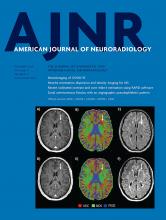Index by author
Ospel, J.M.
- NeurointerventionYou have accessConsiderations for Antiplatelet Management of Carotid Stenting in the Setting of Mechanical Thrombectomy: A Delphi Consensus StatementM. Goyal, S. Yoshimura, G. Milot, J. Fiehler, M. Jayaraman, F. Dorn, A. Taylor, J. Liu, F. Albuquerque, M.E. Jensen, R. Nogueira, J.F. Fraser, R. Chapot, L. Thibault, C. Majoie, P. Yang, N. Sakai, D. Kallmes, K. Orlov, A. Arthur, P. Brouwer and J.M. OspelAmerican Journal of Neuroradiology December 2020, 41 (12) 2274-2279; DOI: https://doi.org/10.3174/ajnr.A6888
Overby, P.
- Adult BrainOpen AccessMRI Brain Findings in 126 Patients with COVID-19: Initial Observations from a Descriptive Literature ReviewE. Gulko, M.L. Oleksk, W. Gomes, S. Ali, H. Mehta, P. Overby, F. Al-Mufti and A. RozenshteinAmerican Journal of Neuroradiology December 2020, 41 (12) 2199-2203; DOI: https://doi.org/10.3174/ajnr.A6805
- PediatricsOpen AccessVessel Wall Enhancement and Focal Cerebral Arteriopathy in a Pediatric Patient with Acute Infarct and COVID-19 InfectionE. Gulko, P. Overby, S. Ali, H. Mehta, F. Al-Mufti and W. GomesAmerican Journal of Neuroradiology December 2020, 41 (12) 2348-2350; DOI: https://doi.org/10.3174/ajnr.A6778
Ozluk, E.
- FELLOWS' JOURNAL CLUBNeurointerventionYou have accessTreatment of Ruptured Blister-Like Aneurysms with the FRED Flow Diverter: A Multicenter ExperienceM.A. Möhlenbruch, F. Seker, E. Özlük, O. Kizilkilic, E. Broussalis, M. Killer-Oberpfalzer, C.J. Griessenauer, M. Bendszus and N. KocerAmerican Journal of Neuroradiology December 2020, 41 (12) 2280-2284; DOI: https://doi.org/10.3174/ajnr.A6849
In a retrospective multicenter study, all patients treated with the FRED for a ruptured intracranial blister-like aneurysm between January 2013 and May 2019 were analyzed. In total, 30 patients with 30 ruptured blister-like aneurysms were treated. Immediate complete aneurysm obliteration with the FRED was achieved in 10 patients (33%). Of the 26 patients with follow-up, complete obliteration was achieved in 21 patients (80%) after 6 months and in 24 patients (92%) in the final follow-up (median, 22 months). The authors conclude that treatment of ruptured blister-like aneurysms with the FRED is safe and effective.
Papinutto, N.
- EDITOR'S CHOICEAdult BrainOpen AccessNeurite Orientation Dispersion and Density Imaging for Assessing Acute Inflammation and Lesion Evolution in MSS. Sacco, E. Caverzasi, N. Papinutto, C. Cordano, A. Bischof, T. Gundel, S. Cheng, C. Asteggiano, G. Kirkish, J. Mallott, W.A. Stern, S. Bastianello, R.M. Bove, J.M. Gelfand, D.S. Goodin, A.J. Green, E. Waubant, M.R. Wilson, S.S. Zamvil, B.A. Cree, S.L. Hauser, R.G. Henry, and and University of California, San Francisco MS-EPIC TeamAmerican Journal of Neuroradiology December 2020, 41 (12) 2219-2226; DOI: https://doi.org/10.3174/ajnr.A6862
Neurite orientation dispersion and density imaging (NODDI) assesses microstructural features of neurites contributing to diffusion imaging signals. Twenty-one subjects with MS underwent serial enhanced MRIs including NODDI, the key metrics of which are the neurite density and orientation dispersion index. Twenty-one age- and sex-matched healthy controls underwent unenhanced MR imaging with the same protocol. NODDI is a promising tool with the potential to detect acute MS inflammation. The observed heterogeneity among lesions may correspond to gradients in severity and clinical recovery after the acute phase.
Park, S.
- Adult BrainOpen AccessDevelopment and Validation of a Deep Learning–Based Automatic Brain Segmentation and Classification Algorithm for Alzheimer Disease Using 3D T1-Weighted Volumetric ImagesC.H. Suh, W.H. Shim, S.J. Kim, J.H. Roh, J.-H. Lee, M.-J. Kim, S. Park, W. Jung, J. Sung, G.-H. Jahng, and for the Alzheimer’s Disease Neuroimaging InitiativeAmerican Journal of Neuroradiology December 2020, 41 (12) 2227-2234; DOI: https://doi.org/10.3174/ajnr.A6848
Parker, R.A.
- Adult BrainOpen AccessNAA is a Marker of Disability in Secondary-Progressive MS: A Proton MR Spectroscopic Imaging StudyB.S. Solanky, N.A. John, F. DeAngelis, J. Stutters, F. Prados, T. Schneider, R.A. Parker, C.J. Weir, A. Monteverdi, D. Plantone, A. Doshi, D. MacManus, I. Marshall, F. Barkhof, C.A.M. Gandini Wheeler-Kingshott, J. Chataway and for the MS-SMART InvestigatorsAmerican Journal of Neuroradiology December 2020, 41 (12) 2209-2218; DOI: https://doi.org/10.3174/ajnr.A6809
Parodi, A.
- PediatricsOpen AccessPerinatal Arterial Ischemic Stroke in Fetal Vascular Malperfusion: A Case Series and Literature ReviewA.F. Geraldo, A. Parodi, M. Bertamino, F. Buffelli, S. Uccella, D. Tortora, P. Moretti, L. Ramenghi, E. Fulcheri, A. Rossi and M. SeverinoAmerican Journal of Neuroradiology December 2020, 41 (12) 2377-2383; DOI: https://doi.org/10.3174/ajnr.A6857
- PediatricsOpen AccessNeonatal Developmental Venous Anomalies: Clinicoradiologic Characterization and Follow-UpA.F. Geraldo, S.S. Messina, D. Tortora, A. Parodi, M. Malova, G. Morana, C. Gandolfo, A. D’Amico, E. Herkert, P. Govaert, L.A. Ramenghi, A. Rossi and M. SeverinoAmerican Journal of Neuroradiology December 2020, 41 (12) 2370-2376; DOI: https://doi.org/10.3174/ajnr.A6829
Pasarikovski, C.R.
- EDITOR'S CHOICENeurointerventionYou have accessEndovascular Cerebral Venous Sinus Imaging with Optical Coherence TomographyC.R. Pasarikovski, J.C. Ku, J. Keith, J. Ramjist, Y. Dobashi, S.M. Priola, L. da Costa and V.X.D. YangAmerican Journal of Neuroradiology December 2020, 41 (12) 2292-2297; DOI: https://doi.org/10.3174/ajnr.A6909
Endovascular optical coherence tomography imaging was feasible in this preclinical animal study. Adoption of this imaging technique in the human cerebral venous sinus could aid in the diagnosis, treatment, and understanding of the pathophysiology of various diseases of the sinus.
Pearly Ti, J.
- NeurointerventionYou have accessCan a Stent Retriever Damage the JET 7 Reperfusion Catheter?J. Pearly Ti, L. Yeo and G. AnilAmerican Journal of Neuroradiology December 2020, 41 (12) 2317-2319; DOI: https://doi.org/10.3174/ajnr.A6804
Piechowski-jozwiak, B.
- FELLOWS' JOURNAL CLUBNeurointerventionOpen AccessCharacteristics of Large-Vessel Occlusion Associated with COVID-19 and Ischemic StrokeS. John, P. Kesav, V.A. Mifsud, B. Piechowski-Jozwiak, J. Dibu, A. Bayrlee, H. Elkambergy, F. Roser, M.S. Elhammady, K. Zahra and S.I. HussainAmerican Journal of Neuroradiology December 2020, 41 (12) 2263-2268; DOI: https://doi.org/10.3174/ajnr.A6799
Consecutive ischemic stroke and TIA admissions (COVID and non-COVID) to the authors' hospital during a 10-week period from March 1 to May 10, 2020 were collected and compared with data from the same time period in 2019. Among 20 patients with COVID-19 and acute ischemic stroke, 15 (75%) had large-vessel occlusion. These patients were young (mean age, 46.5 years), male (93%), without major burden of traditional cardiovascular risk factors, and had a severe stroke presentation. Large vessel occlusions were observed in multiple vessels (40%), uncommonly affected vessels, and atypical locations with a large thrombus burden.








